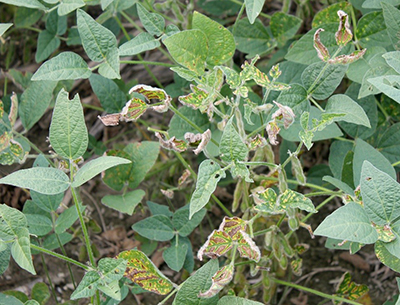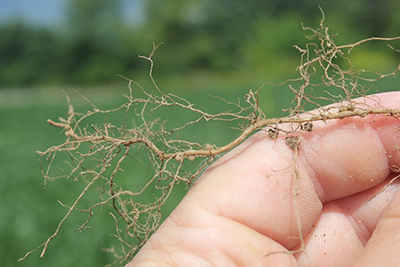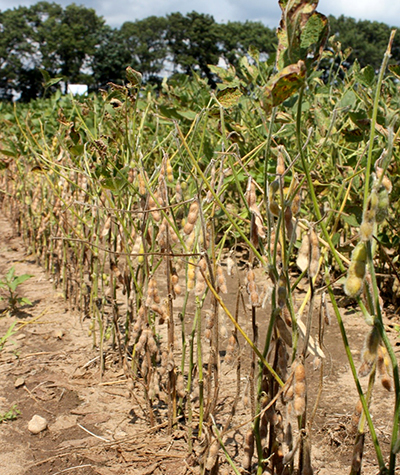Soybeans yellowing too soon?
If premature yellowing or leaf drop in soybeans isn’t caused by moisture stress, it could be from one of these pests or diseases.

Soybean production will be drawing to a close within the next couple of weeks depending upon when the fields were planted, their maturity group and the growing conditions. Here in the southernmost part of Michigan, our earliest planted beans are already beginning to reach maturity. But before the leaves drop off in earnest and the combines begin to roll, soybeans often provide us with an excellent opportunity to scout fields one last time to help identify production problems. The two weeks before senescence can provide an opportunity to look into problem areas of fields and determine what may have caused challenges during the growing season.
What we want to look for is areas of the field that are beginning to show premature yellowing or leaf drop. In some instances, this may be related to water, either too much or too little, during a critical growth stage. These tend to occur on hillsides, low areas or in pockets where soil texture is quite a bit different from the majority of the field.
If moisture is not the obvious culprit, then it is usually worthwhile to walk out to the area and see what is actually causing the problem. Michigan State University Extension has put together some common symptoms and their causes.
Sudden death syndrome (SDS)
Plants begin to show bright yellow discoloration of the leaf margins with brownish or necrotic tissue between the leaf veins. Leaves often take on a “crispy” appearance, especially if conditions are somewhat dry. This may be particularly notable on headlands where soil compaction may be greatest. With late onset SDS, these symptoms are the most common. If SDS was more severe, plants may appear stunted, often losing their leaves early. Also, leaf petioles may remain attached when SDS is involved.
Incidence of SDS has been quickly rising, especially in southwest Michigan. While severity has not been widespread yet, the causal pathogen can accumulate in the soil, causing more severe outbreaks if susceptible varieties and weather conditions are right. Brown stem rot also presents these symptoms. Split stems to look for discoloration of the pith to distinguish this disease from SDS.

Look for bright yellow and brown contrasting interveinal patterns on upper leaves in fields showing advanced symptoms of SDS. Minor infections may show a much more subtle yellowing pattern on leaves. Early onset of SDS may cause leaflets to drop off the plant completely, leaving only the petioles (leaf stems) attached.
Soybean cyst nematodes
Nematodes often cause plants to be yellowed, stunted or drop their leaves early. Take a trowel out with you and dig up and examine the roots. Often, you will find the telltale cysts on the roots; look like small, whitish bumps on roots.
If you have cysts, be sure to note the area and come back after harvest to sample through the root masses for soybean cyst nematodes. Understanding total counts and biotypes can be an important consideration for control. The most common source of soybean cyst nematode resistant varieties, PI88788, will not control some biotypes of this pest in Michigan.

Examine roots for incidence of soybean cyst nematodes. Soil should be loosened before root removal to avoid pulling off the cysts.
Spider mites
Twospotted spider mites can cause premature leaf drop if they are present in high enough numbers. They are usually not a significant problem in moist years because pathogenic fungi often keep their numbers in check. However, fields that were dry for an extended period, particularly in a portion of the field adjacent to a dusty road or a well-travelled farm lane, can help the pest to overcome the natural controls.
Initial symptoms are a stippling-looking yellowing, followed by a bronzing appearance. Defoliation can occur in heavy infestation areas. At 0.02 inches in length, they are tough to see. Take a loupe and look for webbing on the back of leaves.

Spider mite feeding stippling from a previous infestation of spider mites in Cass County on Aug. 20, 2015.
Soybean aphids
While soybean aphids can be problematic early in the growing season, they rarely if ever cause significant yield loss in the last couple of weeks before senescence. However, feeding from soybean aphids can lead to plants that look weird towards the end of the growing season. High levels of soybean aphid feeding sometimes cause a bright yellow potassium deficiency symptom along the leaf margin. Heavy aphid feeding will often promote the formation of dark sooty molds on the surfaces of leaves from the fungi that feed on the aphid’s honeydew.
White mold
This disease does not present itself as a premature yellowing because most of the leaves are already gone by this time of year. Look for dead stems that remain visible towards the end of the growing season. Be sure to look for them as you are scouting spots of premature yellowing or leaf drop. Since combines can spread white mold sclerotia from field to field, you may want to consider harvesting fields with high incidence of white mold last or clean your combine out between fields to limit spread of this long-lived disease.

Heavy incidence of white mold in a Cass County irrigated soybean field.
Taking the time to look at areas of premature color change or leaf drop can really help to identify some of the more serious diseases and pests in soybean fields. A little time invested in August can pay be dividends in managing soybeans the next time they are planted in the field. It is particularly important to know if you have incidence of white mold or SDS in fields as these diseases can accumulate over time and can potentially cause devastating yield losses.

Near total leaf loss caused by early onset of SDS symptoms on a susceptible variety at the Soybean Disease Research Site near Decatur, Michigan, on Aug. 19, 2015.



 Print
Print Email
Email

